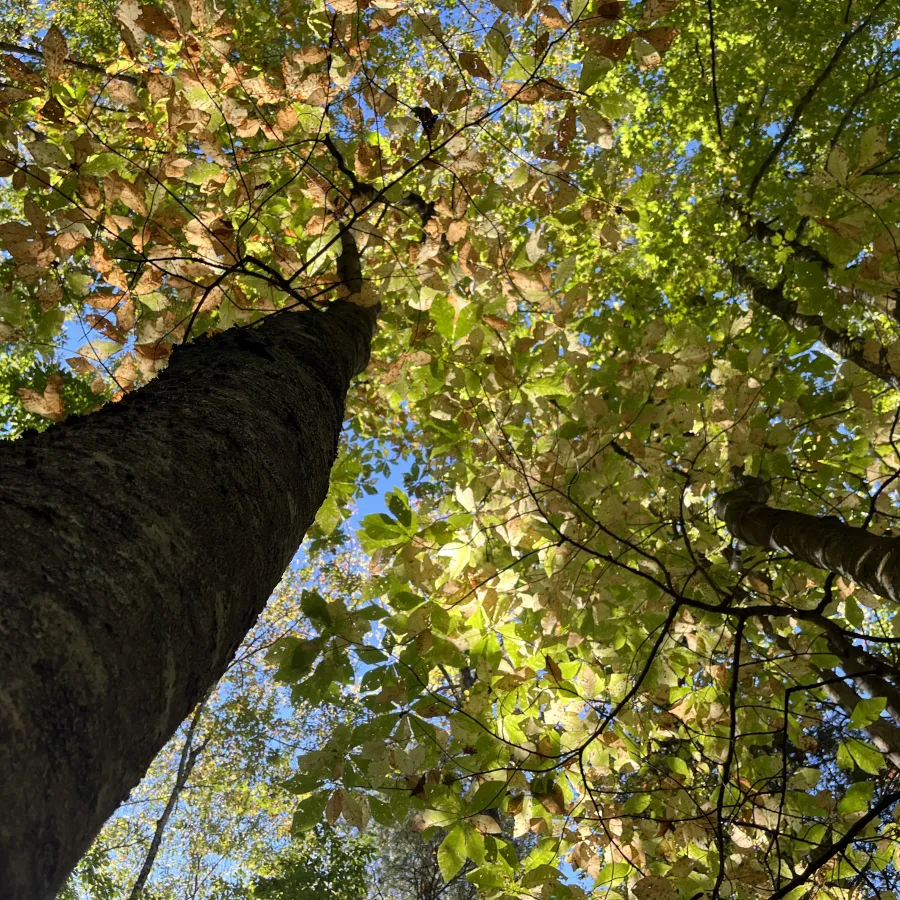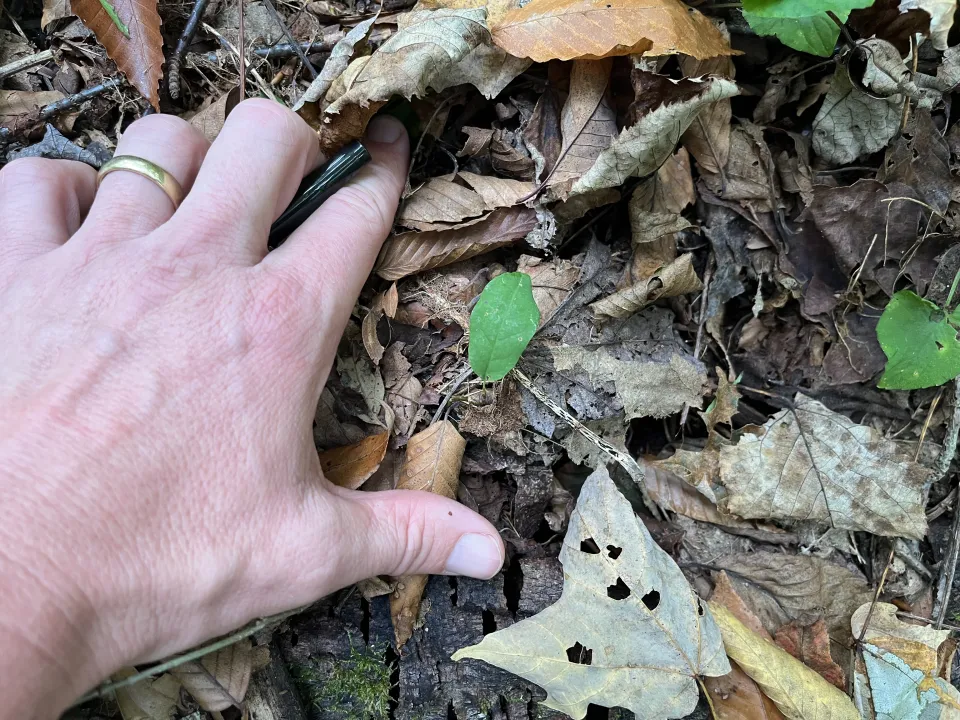Rescue from the Elevator to Extinction
Botanic Garden - Leaflet
Leaflet 2022

Published March 26, 2024
In the past two years, the Botanic Garden of Smith College has undergone its most profound rethinking of collections-building priorities since our inception. The 28 projects outlined in our newly crafted Collections Management Plan serve critical needs within increasingly imperiled botanical communities and give our students meaningful access to that work. This year has allowed us to move forward with a number of these projects, connecting them with both regional and national conservation partnerships. The most notable of these efforts ties together two forested hillsides, separated by hundreds of miles.
The first hillside is a sunny slope at Smith’s Ada and Archibald MacLeish Field Station in Whately, Massachusetts. This beautiful spot, easily accessible to Smith College students and faculty, was an ecological mess at the start of the summer of 2021, drowning in invasive bittersweet vines and multiflora rose shrubs. The second is the pristine western slope of Virginia’s tallest mountain, Mount Rogers. The long elevation gradient to the valleys below has proven to be ideal habitat for one of the continent's most understudied and underappreciated magnolia species, mountain magnolia (Magnolia fraseri). Information about the ecological health of this species is almost completely absent from the scientific literature and it is notably underrepresented in botanical collections as well. Mountain magnolia’s preferred habitat is a narrow niche in an area that is rich in rare and small-range species: the southern Appalachian Mountains. This lack of data, combined with a lack of attention and known risk factors for extinction, raises both questions and concerns over the current conservation status and the species’ ability to survive in a changing climate. During the summer of 2021 we set out to transform the site at MacLeish into a living genebank for species in need of conservation and to determine if mountain magnolia was in need of that help.
The work at MacLeish began with invasive vine and shrub removal and the gathering of soil samples for analysis. After removing harmful vegetation and dead trees that had been smothered by bittersweet, we were left with an ideal dappled-light environment for growing native magnolias. The botanic garden’s inaugural conservation intern, McKenzie Swart ’21, not only helped us prepare the land but conducted an assessment of which botanical institutions currently steward mountain magnolia trees. This research confirmed that mountain magnolia’s genome is not well captured in arboreta, which often serve as genetic backups in cases where natural populations are lost. But it also revealed something optimistic: Despite its Southern provenance, the species is surprisingly tolerant of the type of cold experienced in central New England’s winters.
At the end of last summer, I traveled to the Mount Rogers National Recreation Area with Associate Professor of Biological Sciences Jesse Bellemare to attempt to clarify the conservation status of mountain magnolia. It is the only native magnolia with an exclusively montane habitat, which makes it an ideal study species to determine if it is being harmed as climate change pushes its preferred climate up the slopes.
Mountains are known to provide refuge for species in times of climate change because their climate zones and varied habitats are spatially compressed. A short move up- or downslope can offer the same conditions that would be experienced by moving much greater distances to the north or south. For hundreds of thousands of years, this ability to change elevation helped mountain magnolia survive ice ages as it moved downslope to more mild climates in the valleys during the long cold period, and survive warming periods when the species found cooler climes at higher altitudes. However, the resilience of mountain landscapes has its limits when climate warms, especially when it does so quickly.
This research began by looking at areas where mountain magnolia occurred across its preferred elevation range. At these sites, we counted the occurrence of mature, seed-producing trees and seedlings. The ratio of old trees to young is revealing. The presence of mature, seed-producing trees at a site indicates that the climate of the recent past was suitable for seeds to successfully germinate, grow through the delicate seedling phase, and mature. In contrast, the presence of seedlings indicates that the climate of the last few years was within a suitable range for the next generation of mountain magnolias to establish and begin their journey toward maturity. In a stable climate, one would expect to find that the number of seedlings at any site within a species’ ideal habitat range is proportional to the number of mature trees; the presence of seedlings should be in sync with where the seeds are being produced. However, in times of changing climate, these two life stages tend to diverge. Established adults are much more hardy and tolerant of a wider range of temperatures and moisture levels; thus the population of mature trees would likely be unaltered by the early effects from climate change. On the other hand, seedlings are far more fragile and sensitive to smaller changes in climate. With our current human-caused accelerated warming trend, this decline in seedlings would be evident at the lower altitudes first as the regeneration of new populations shifts upslope where the weather is cooler. This divergence of life-stage distributions tells us that the species is being moved by a changing climate.
There are many factors that affect how plant distributions play out in the natural environment, and detecting shifts like this often produces a messy, unclear picture. Then again, every once in a while, the tale the data tells is crystal clear. What we found throughout our work was stark and astonishing. Our data painted a clear picture of a species that, despite ample seed production at all elevations, was failing to reproduce itself at the lower two-thirds of its elevation range! This strongly suggests that mountain magnolia may not be ecologically viable at these elevations anymore: The older trees are now unable to replace themselves, resulting in a slow-moving population collapse. This condition has earned many species in similar situations the grim description “the living dead” as the mature individuals are slowly lost from the population. Further upslope, a different story emerged. Seeds were turning into viable seedlings year after year toward the upper elevation limit, supporting our suspicion that the climate envelope that allows this species to regenerate itself is moving up the mountains very quickly.

Environmental optimists may look at this data and think that it appears that mountain magnolia is doing exactly what it ought to and something it has likely done through numerous prior global warm periods: It is moving up the mountain to cooler ground with the climate. However, the rate of climate change at present is so fast that the unique genes that characterize the lower populations may not be moving up the mountain and could be lost from the genome, resulting in lost genetic diversity and leading to what biologists call a genetic bottleneck. The outcome of such a bottleneck may still be enough individuals to reproduce and survive, but also a species with substantially fewer unique genetic tools on its proverbial toolbelt to adapt to new challenges. Additionally, the upper-elevation seeds may not be able to disperse far enough upslope to keep pace with the shifting climate. Then there’s the issue of space. As montane species move upslope, they are confined to smaller and smaller circles of habitat and will eventually have nowhere else to climb. This is where the resilience of mountain habitats reaches its limit—a phenomenon that scientists have started calling the “escalator to extinction.”
As part of the Collections Management Plan, we have partnered with the Global Conservation Consortium for Magnolia, a new conservation effort aimed at building networked collections for threatened plants that cannot be preserved through seed banking. The seeds of magnolia are what seed physiologists call recalcitrant, meaning they cannot tolerate the freezing and drying process that is essential for long-term seed banking and therefore must be held in living collections—arboreta. These collections must be carefully planned to ensure that a sufficient portion of the species genome is captured. When done right, these efforts safeguard the adaptive capacity and resilience that is held within these living gene banks.
A challenge with building these types of collections is that they require so many trees—sometimes scores or even hundreds—to adequately capture a large enough sample of the genetic diversity found throughout the species’ natural range. This requires a lot of space and a commitment to steward these long-lived plants for decades, if not centuries. The ultimate fate of these tree species may hang on the success of this work. This brings us back to the sunny hillside at MacLeish.
In 2022, the Botanic Garden of Smith College will be receiving the first specimens of mountain magnolia through the Global Conservation Consortium for Magnolia. They will be cared for by future conservation interns at the botanic garden and will constitute the first building blocks of a metacollection—a collection of collections held by multiple institutions—that will serve as a firewall against the extinction of a beautiful and underappreciated star of southern Appalachian mountain sides. Smith classes will be exposed to this new imagining of the role of botanic gardens and will be invited to help grow the trees, collect and manage data, and interpret the information that only living collections can provide.